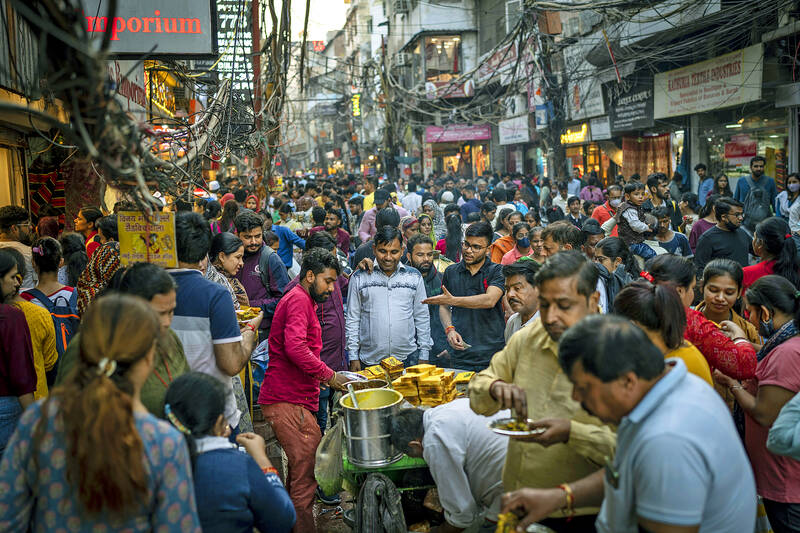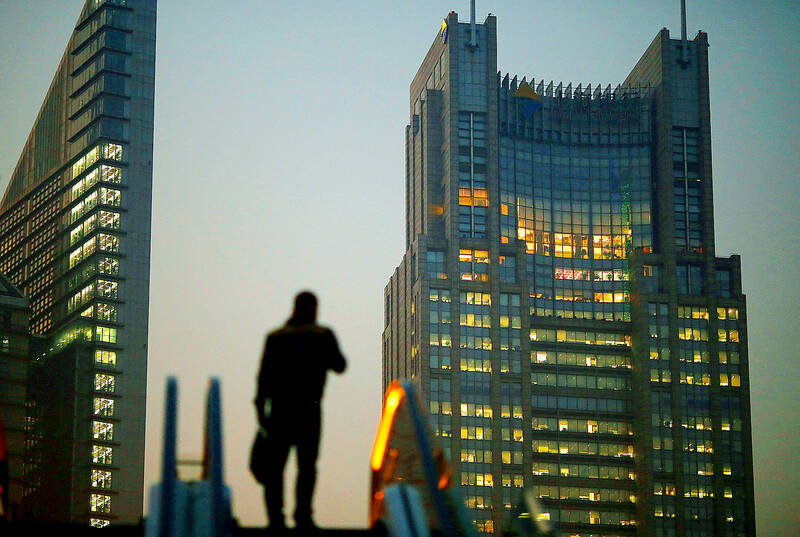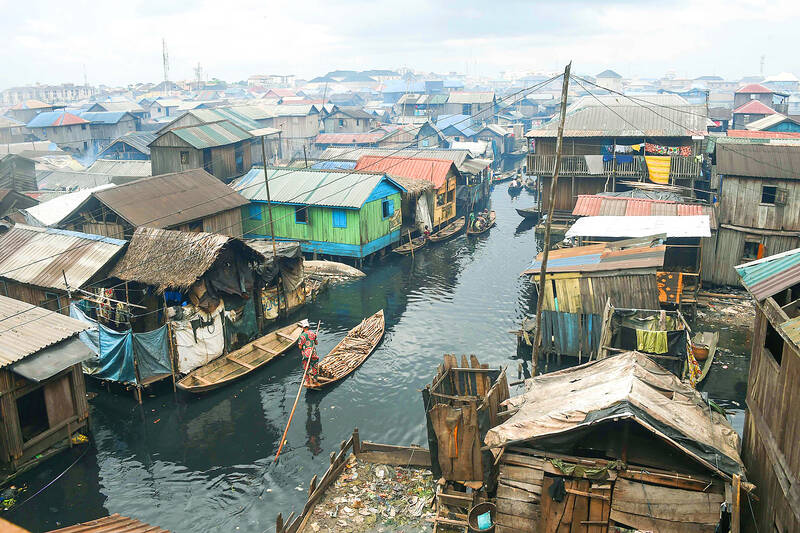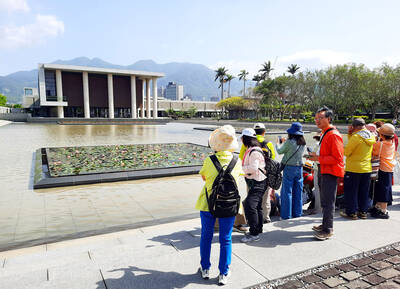On the day India surpasses China as the world’s most populous nation, the change for both countries will be psychological and symbolic.
China will still be the greater economic power, the one challenging the US for full superpower status, but it will no longer be able to call itself the largest nation by sheer numbers.
On present trends, the population gap will continue to widen rapidly, but what that will mean for their relative clout in the world will be decided by a host of other factors such as investment and governance. Demographics are not destiny.

Photo: AP
POPULATION CONTRACTION
However, the moment the baton is passed to India will plant a seed of doubt, hinting at possible limits to China’s relentless rise in the 21st century. China’s population of 1.4 billion is expected to start shrinking soon and at an increasing rate.
“The presumption was that they were going to max out in population in 2028, but now it looks like they already have, and that’s a very big change,” said Ian Bremmer, the president and founder of Eurasia Group, a political risk research and consulting firm.

Photo: Reuters
“The Chinese are facing a population contraction that is far greater than anything experienced by Japan or South Korea, and they’re going to be facing it as they’re still only a middle income economy, so this is a huge challenge for them,” he added.
Not only will Chinese population shrink, but its age profile will also change. The bulge will no longer be in the working-age generation, but increasingly among elderly people. The number of Chinese citizens over 65 will more than double by 2050, from 150 million to 330 million. There will be fewer and fewer people whose labor will support more and more retirees. The profile will cease to resemble an onion dome on a Russian church and start to look like a kite, or a coffin.
The Chinese leadership could find ways of allowing the country to grow, through increasing the productivity of those in work, but it will take capital — and more and more of it as time goes on. China is in a race, trying to get rich before it gets old.

Photo: AFP
Through that prism, China’s military spending is a bet that it will bend a large part of the world to its will so that it gains privileged access to resources. But if that bet fails, Beijing will have spent a lot of capital that could have been used to adapt its economy to the encroaching limits, leaving the country stuck in a middle-income trap.
India will face similar dilemmas as its population grows. There will be more Indians of working age in relation to the elderly parents they will have to fund, but the leadership will have to be agile to reap the demographic dividend.
“The demographic dividend doesn’t happen automatically, because that big group of young working-age people need to have work and they need to be productive,” said Stuart Gietel-Basten, professor of humanities and social sciences at Khalifa University in Abu Dhabi.
Some countries have managed to seize the opportunity offered by the demographic dividend, like South Korea and Singapore. Those that have not face the challenge of increasing the number of young people unable to find a job, raising the prospect of unrest, which were the dynamics underlying the 2011 Arab spring in Tunisia, Egypt and Syria.
The determinants of success or failure can be many and varied, Gietel-Basten suggested. “It will be about resources, about governance, about infrastructure, about location,” he said.
Carla Norrlof, professor of political science at the University of Toronto, points out that outside powers such as the US could seek to have an influence on the relative development of the two population giants, by calibrating access to the technologies that will help determine growth in both.
“The US now is really set on limiting China’s economic influence, and so India might kind of piggyback on that if it’s not being targeted in terms of technology restrictions,” Norrlof said.
AFRICA BENEFITS?
By 2050, the current trends suggest, only a few countries will be accounting for all the world’s population growth, most of them in Africa.
Hans Rosling, a Swedish physician and academic, said the world’s current “pin code” was 1114, meaning there are very roughly 1 billion people in the Americas, Europe and Africa and 4 billion in Asia. In 2050, the code will be 1145, with 4 billion in Africa and 5 billion in Asia.
It is possible countries such as Nigeria or Ethiopia could reap a dividend and vault out of poverty. Whether they do or not, Africa’s severe under-representation in global institutions, starting with the UN, is unlikely to be tenable. Stewart Patrick, the director of the global order and institutions program at the Carnegie Endowment for International Peace, said that as continent’s population grows it will be the focus of ever more geopolitical wrangling.
“It will be a second scramble for Africa, with pretty strong competition,” Patrick said. “Africa is obviously a source of tremendous amount of raw materials, including oil and gas but then also raw materials for the clean energy transition, the sort of minerals that one needs to build batteries and things like that.”
The degree to which African countries are able to manage their growth successfully will only increase the amount of fossil fuels their rising populations will require to meet their expectations.
That bulge in energy demand will not be offset by China’s population decline, because its smaller population will still be straining for middle-class lifestyles, which consume much more energy.
The steeper the demographic gradient grows between a burgeoning global south and a contracting north, the greater the pressure of migration.
It would make economic sense for wealthy shrinking nations in North America and Europe to take in people to do the work to support their ageing populations, but that brings a backlash.
“There might be some kind of realization that aging populations in wealthy countries is a real problem and they need to import more labor,” Norrlof said. “But I think that in the current political climate, that’s not what we’re seeing at all.

When the South Vietnamese capital of Saigon fell to the North Vietnamese forces 50 years ago this week, it prompted a mass exodus of some 2 million people — hundreds of thousands fleeing perilously on small boats across open water to escape the communist regime. Many ultimately settled in Southern California’s Orange County in an area now known as “Little Saigon,” not far from Marine Corps Base Camp Pendleton, where the first refugees were airlifted upon reaching the US. The diaspora now also has significant populations in Virginia, Texas and Washington state, as well as in countries including France and Australia.

On April 17, Chinese Nationalist Party (KMT) Chairman Eric Chu (朱立倫) launched a bold campaign to revive and revitalize the KMT base by calling for an impromptu rally at the Taipei prosecutor’s offices to protest recent arrests of KMT recall campaigners over allegations of forgery and fraud involving signatures of dead voters. The protest had no time to apply for permits and was illegal, but that played into the sense of opposition grievance at alleged weaponization of the judiciary by the Democratic Progressive Party (DPP) to “annihilate” the opposition parties. Blamed for faltering recall campaigns and faced with a KMT chair

Article 2 of the Additional Articles of the Constitution of the Republic of China (中華民國憲法增修條文) stipulates that upon a vote of no confidence in the premier, the president can dissolve the legislature within 10 days. If the legislature is dissolved, a new legislative election must be held within 60 days, and the legislators’ terms will then be reckoned from that election. Two weeks ago Taipei Mayor Chiang Wan-an (蔣萬安) of the Chinese Nationalist Party (KMT) proposed that the legislature hold a vote of no confidence in the premier and dare the president to dissolve the legislature. The legislature is currently controlled

Dull functional structures dominate Taiwan’s cityscapes. But that’s slowly changing, thanks to talented architects and patrons with deep pockets. Since the start of the 21st century, the country has gained several alluring landmark buildings, including the two described below. NUNG CHAN MONASTERY Dharma Drum Mountain (法鼓山, DDM) is one of Taiwan’s most prominent religious organizations. Under the leadership of Buddhist Master Sheng Yen (聖嚴), who died in 2009, it developed into an international Buddhist foundation active in the spiritual, cultural and educational spheres. Since 2005, DDM’s principal base has been its sprawling hillside complex in New Taipei City’s Jinshan District (金山). But